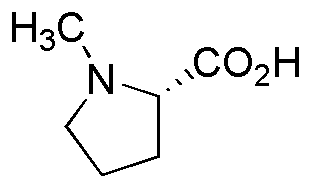N-Methyl-L-proline is widely utilized in research focused on
- Pharmaceutical Development: This compound serves as a building block in the synthesis of various pharmaceuticals, particularly in creating compounds that target neurological disorders.
- Peptide Synthesis: It is used in the formation of peptides, enhancing their stability and bioactivity, which is crucial for drug formulation in the biotech industry.
- Chiral Catalysis: N-Methyl-L-proline acts as a chiral catalyst in asymmetric synthesis, improving the efficiency and selectivity of reactions in organic chemistry.
- Research in Biochemistry: This compound is employed in studies related to protein folding and enzyme activity, providing insights into molecular interactions that are vital for understanding biological processes.
- Cosmetic Formulations: Its unique properties make it a valuable ingredient in cosmetic products, enhancing skin hydration and texture, appealing to the personal care industry.
General Information
Properties
Safety and Regulations
Applications
N-Methyl-L-proline is widely utilized in research focused on
- Pharmaceutical Development: This compound serves as a building block in the synthesis of various pharmaceuticals, particularly in creating compounds that target neurological disorders.
- Peptide Synthesis: It is used in the formation of peptides, enhancing their stability and bioactivity, which is crucial for drug formulation in the biotech industry.
- Chiral Catalysis: N-Methyl-L-proline acts as a chiral catalyst in asymmetric synthesis, improving the efficiency and selectivity of reactions in organic chemistry.
- Research in Biochemistry: This compound is employed in studies related to protein folding and enzyme activity, providing insights into molecular interactions that are vital for understanding biological processes.
- Cosmetic Formulations: Its unique properties make it a valuable ingredient in cosmetic products, enhancing skin hydration and texture, appealing to the personal care industry.
Documents
Safety Data Sheets (SDS)
The SDS provides comprehensive safety information on handling, storage, and disposal of the product.
Product Specification (PS)
The PS provides a comprehensive breakdown of the product’s properties, including chemical composition, physical state, purity, and storage requirements. It also details acceptable quality ranges and the product's intended applications.
Certificates of Analysis (COA)
Search for Certificates of Analysis (COA) by entering the products Lot Number. Lot and Batch Numbers can be found on a product’s label following the words ‘Lot’ or ‘Batch’.
*Catalog Number
*Lot Number
Certificates Of Origin (COO)
This COO confirms the country where the product was manufactured, and also details the materials and components used in it and whether it is derived from natural, synthetic, or other specific sources. This certificate may be required for customs, trade, and regulatory compliance.
*Catalog Number
*Lot Number
Safety Data Sheets (SDS)
The SDS provides comprehensive safety information on handling, storage, and disposal of the product.
DownloadProduct Specification (PS)
The PS provides a comprehensive breakdown of the product’s properties, including chemical composition, physical state, purity, and storage requirements. It also details acceptable quality ranges and the product's intended applications.
DownloadCertificates of Analysis (COA)
Search for Certificates of Analysis (COA) by entering the products Lot Number. Lot and Batch Numbers can be found on a product’s label following the words ‘Lot’ or ‘Batch’.
*Catalog Number
*Lot Number
Certificates Of Origin (COO)
This COO confirms the country where the product was manufactured, and also details the materials and components used in it and whether it is derived from natural, synthetic, or other specific sources. This certificate may be required for customs, trade, and regulatory compliance.


